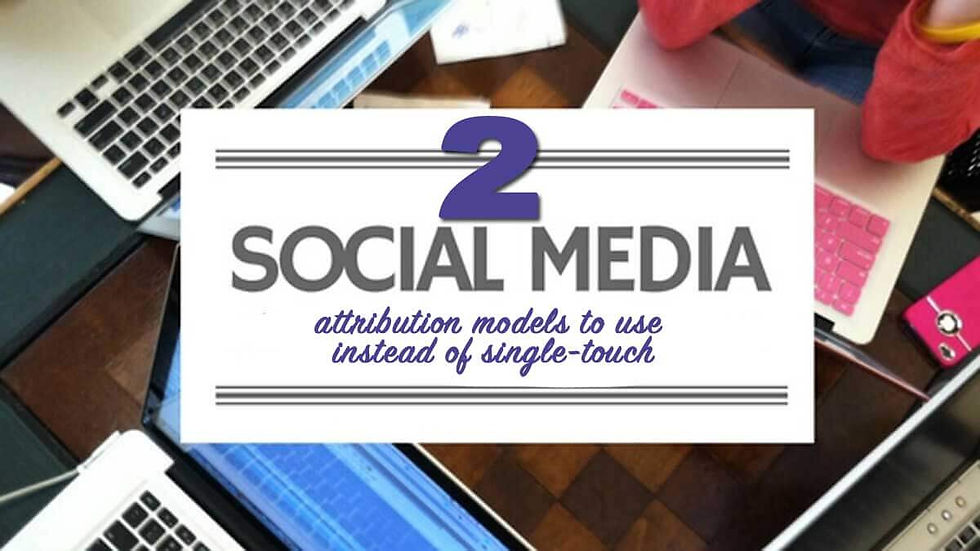Two social media attribution models to use instead of single-touch
- Fahad H

- Jun 7, 2017
- 4 min read

Have you been looking for the best way to measure the effectiveness of each of your social media channels? Do you want to learn how you can pick an effective social media attribution model for your business?
In this article, I’ll describe the three different social media attribution models and how each one uniquely measures the success of your social channels. You can decide which approach will work best for your particular situation.
The single-touch model
The days of referring to social media efforts as strict awareness marketing are long gone. Between promotional posts, blatant CTAs and paid advertising, businesses use their social channels to drive leads and purchases every day. So how do we measure the effectiveness of each channel and effort?
The single-touch social model is based on two types of touches. The first-touch model focuses on the first channel, also known as the discovery channel. No matter where your prospect converts, this model gives all of the credit to the very first instance/place where your prospect found you.
For example, as I was browsing my Instagram, I came across an ad that pertained to comfortable shoes. At the time, I was working the booth at an event and my heels were killing my feet! In that moment, I was convinced to consider these shoes. I then researched them on the web and scrolled through their Twitter feed, but I didn’t buy them just yet.
Later, I saw the same shoes on a Facebook ad, and I purchased them. According to the single-touch model, the initial interaction on Instagram would receive all the credit for the shoe purchase or conversion. This is the most common model, but it is also the least accurate.
First, I went to Instagram and saw the ad:

Then, I went to Twitter to research their newsfeed:

Afterward, I went to their website to see what they were about:

Last, I viewed my Facebook feed, where I came across their Facebook ad:

If I were focusing on a last-touch social model, then all my credit would be given to the Facebook ad that I clicked on to make my purchase. Essentially, this is the last-touch social model. All the credit is given to the last touch point before the conversion happens.
There are tools like Google 360 and Bizible that enable you to measure attribution at any instance, and Google plans to release a free version called Google Attribution. These tools gather data from across multiple touch points in today’s complicated string of customer journeys so that you can view metrics in a simplified way. It’s this information that allows marketers to make smarter decisions about where to focus time, effort and budget across social media.
Optimize your channel marketing with multi-touch model
Unfortunately, single-touch models can be misleading, as we are not sure which touch points were the most effective or convincing. Today, vanity metrics like those provided from single-touch models don’t make the cut. We must dig deeper to understand our metrics and where we need to focus both attention and budget when it comes to social media.
This is where the multi-touch social model comes in handy. It allows you to measure the effectiveness of each and every touch point that leads to the ultimate conversion.
Every touch point is equally weighted in this model. This means each point of contact received the same amount of credit as any other. If I refer to the previous example with the shoes, then all four touch points, from the Instagram news feed to the Facebook ad, would receive the same credit for the closed purchase.
Marketers primarily use the social multi-touch model to understand prospect behavior around the conversion. Which social media channels should they increase their focus on? Which channels should they completely eliminate because they are not influencing conversions?

The multi-touch social model is more precise than the other models because it allows you to measure the entire customer path to purchase. Some marketers may feel that not all touch points are equal, so they look for more of a position-based social model.
Generate more revenue with a position-based model
The position-based social model focuses on giving two touch points on the path to purchase more weight than the other two touch points. You can choose which points have more weight. I’ve seen that most marketers choose to give a higher percentage of weight to the outer points of the model rather than the two inner points of the model.
For example, you can attribute 40 percent of the weight to the first and the last touches of the model. In the Time Slippers shoe example above, we would give 40 percent of the weight to the Instagram news feed and another 40 percent to the Facebook ad.
Then we would attribute 10 percent to the website and 10 percent to the Twitter feed. You can easily move these percentages around based on how your prospects make a purchase.

This social attribution model may lead to different biases based on the impact of your channels. However, if you want to report on your metrics for social media, this approach is more effective than taking a vanity metric approach. Vanity metrics give you a great overall picture of reach and popularity, but they do not connect your channels to revenue.
Conclusion
Social attribution models offer the best options for measuring real social media ROI based on the activity of your prospects. Most of the time, I take a multi-touch social attribution model approach because it helps me understand the customer path, rather than laser-focusing on a couple of touch points that may or may have not been key indicators.
There is no right or wrong way to measure social interactions, but we can certainly aspire to the highest accuracy possible.








Comments